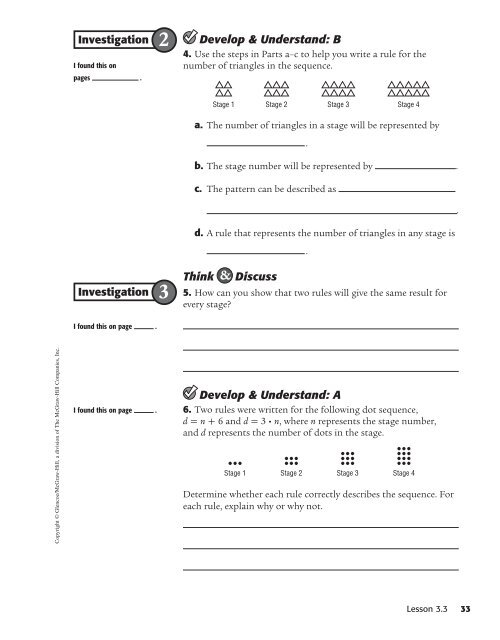Investigation Notebook and Reflection Journal (3057.0K)
Investigation Notebook and Reflection Journal (3057.0K)
Investigation Notebook and Reflection Journal (3057.0K)
You also want an ePaper? Increase the reach of your titles
YUMPU automatically turns print PDFs into web optimized ePapers that Google loves.
<strong>Investigation</strong> 2<br />
I found this on<br />
pages .<br />
Develop & Underst<strong>and</strong>: B<br />
4. Use the steps in Parts a–c to help you write a rule for the<br />
number of triangles in the sequence.<br />
Stage 1<br />
Stage 2<br />
Stage 3<br />
Stage 4<br />
a. The number of triangles in a stage will be represented by<br />
.<br />
b. The stage number will be represented by .<br />
c. The pattern can be described as<br />
.<br />
d. A rule that represents the number of triangles in any stage is<br />
.<br />
<strong>Investigation</strong> 3<br />
Think<br />
&<br />
Discuss<br />
5. How can you show that two rules will give the same result for<br />
every stage?<br />
I found this on page .<br />
Copyright © Glencoe/McGraw-Hill, a division of The McGraw-Hill Companies, Inc.<br />
I found this on page .<br />
Develop & Underst<strong>and</strong>: A<br />
6. Two rules were written for the following dot sequence,<br />
d = n + 6 <strong>and</strong> d = 3 · n, where n represents the stage number,<br />
<strong>and</strong> d represents the number of dots in the stage.<br />
Stage 1<br />
Stage 2<br />
Stage 3<br />
Stage 4<br />
Determine whether each rule correctly describes the sequence. For<br />
each rule, explain why or why not.<br />
Lesson 3.3 33

















